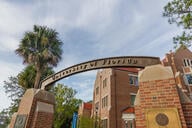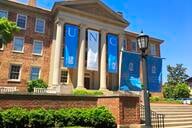You have /5 articles left.
Sign up for a free account or log in.
It’s a tough time to be a president in higher education, experts and onlookers said last spring when the COVID-19 pandemic sent colleges spiraling.
The job is even tougher this fall, as colleges work to keep students, faculty and staff healthy; sort out rocky finances; prepare for a divisive election; and address structural racism at their institutions.
Amid all of this, some colleges are also in the middle of leadership turnover. With little warning and no time to prepare, interim presidents have stepped in to lead numerous colleges through one of higher education’s most difficult years.
Vann Newkirk Sr., interim president at Fisk University in Nashville, Tenn., stepped in to lead the historically Black university when its former president, Kevin Rome Sr., was dismissed after allegations surfaced that Rome drugged and threatened a man. Newkirk’s August appointment to interim president was unexpected, and he’s not sure how long he’ll stay in the role.
“Right now, as an institution, we’re on the upswing. As interim president, my job is not to turn us back or slow us down, but to accelerate our movement forward,” he said. “I guess we’ll reassess when the board is ready to reassess.”
Halfway through the fall semester and nearly three months into his interim presidency, Newkirk said things are going well. This fall enrollment increased to 910 from 885 last academic year. The university brought back all of its students in seven-week blocks: half were on campus for the first part of the semester, and half have returned for the latter part. In total, eight students, faculty and staff members have tested positive for the virus this semester.
Newkirk was Fisk University’s provost before his appointment to interim president. He thinks he would be interested in a full-time president position someday.
“Coming on board as an interim during a time of crisis, and how you handle it, gives you a good perspective of what it could be during good times,” he said.
Wichita State University’s interim president, Rick Muma, was also appointed following a former president’s controversial departure. Jay Golden resigned from the presidency of the public university in Kansas at the end of September, after months of speculation over his future there. Golden had been in hot water with the Kansas Board of Regents after the university canceled a planned commencement speech by Ivanka Trump.
Muma also served as Wichita State’s interim president prior to Golden’s arrival, after former president John Bardo died in March 2019.
“The last time was a lot different because the president was ill and he finally passed away, so that was a much more gradual process that I integrated into,” Muma said. “This time around, the president resigned and it’s much more sudden.”
Nonetheless, Muma felt prepared for the job. In addition to serving as provost, he's been executive vice president at the university, and he has worked at Wichita State in some capacity for 25 years. Prior to a career in higher education, Muma was a health-care provider working in infectious disease, particularly with HIV patients. He thinks his experience lends him credibility to lead during a pandemic.
“I don’t feel like I have problems with people who don’t feel I have the authority or the legitimacy to move the campus forward,” Muma said.
As interim president of the University of Bridgeport, a private nonprofit institution in Connecticut, Stephen Healey has been saddled with an additional challenge: the university is being acquired by neighboring Goodwin University and the Paier College of Art. Healey stepped into the role in April after the university's former president, Laura Skandera Trombley, left to become president of Southwestern University.
He expects to remain interim president until the acquisition is complete and is uncertain if there will be a position for him on campus afterward.
“I don’t know exactly the model that will be used there, but it will not need a stand-alone presidency,” he said. “Whatever it is, I’m ready for it.”
Leading a university being acquired may be relatively unusual in higher education. But Healey doesn't think he's facing circumstances that are less ordinary than those faced by other interim presidents in this unusual year.
“Everything about higher education right now is unusual,” Healey said. “COVID-19 has changed everything. We’re running a lot of stuff -- and discovering that it can be done -- from a distance, with Zoom and Skype and digital connection.”
Jim Borsig, interim chancellor of Henderson State University in Arkadelphia, Ark., is also managing a merger. The public liberal arts university last year announced it would become part of the Arkansas State University system, following financial trouble. After suspending a chancellor search last spring, the Arkansas State system Board of Trustees found Borsig through The Registry, an organization that helps place interim presidents, chancellors and other C-suite higher education professionals.
Borsig had experience as a college president. From 2012 to 2018, he served as president of the Mississippi University for Women, a coeducational public university. Unlike many other interim presidents, Borsig was an outsider when he arrived at Henderson. Establishing his credibility was important.
“You have to be visible, and you have to listen,” he said. It frustrates him that he can’t be more physically present on campus, but through Zoom calls and small, socially distant events, he’s working to familiarize himself with faculty, staff members and students.
He knows that the challenges of virtual work extend to everyone at the university.
“We’re trying to solve for X, but the problem is that every other variable on the other side of the equals side is also unknown,” he said about running a college during the pandemic.
Borsig is not in the running for the permanent chancellorship. His contract through The Registry stipulates that he cannot be considered for the permanent role. He says that the caveat helps clear up confusion about his role at the university.
Carol Moore, interim president at Guilford College, a private nonprofit institution in North Carolina, was also placed via The Registry. Guilford is her second placement through the interim-matching organization -- in 2016, she served as interim provost at Columbia College in Columbia, S.C., and later became president there.
Demand for interim placements is on the rise, according to Bryan Carlson, president of The Registry. The Registry has placed 261 interim professionals, more than 20 of them presidents, at colleges this year. This surpasses the 251 they had placed as of November 2019.
Last spring, many retiring college presidents held off announcing their departures until the start of the pandemic had passed, leading to a surge of retirement announcements and subsequent interim appointments this fall.
Lori Berquam is fairly new to Mesa Community College, a public two-year college in Mesa, Ariz., that enrolls about 20,000 students. She arrived in July 2019 to fill a newly created position as executive vice president of academic and student affairs. After former president Richard Haney resigned in January, Berquam stepped in as interim president.
“I had about one month as the interim, and then I was having virtual meetings,” she said.
One of Berquam’s biggest priorities is ensuring that Mesa students receive crucial wraparound services even during the pandemic. The college provided laptops and hotspots for students, operates a drive-through food bank, and offers drive-through COVID-19 testing and flu shots free of charge.
So far she enjoys serving as interim president, but she doesn’t know how long she’ll be in the role.
“What I’ve learned is that I could be a college president,” Berquam said. “This certainly gives you an appreciation for what the role means.”




